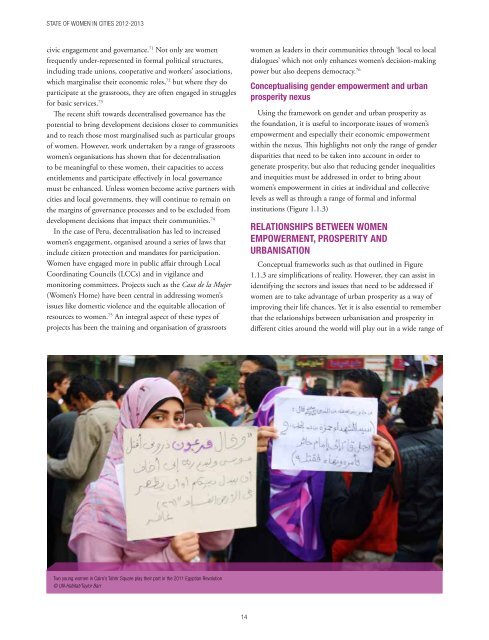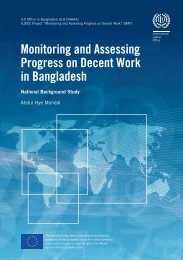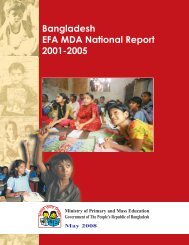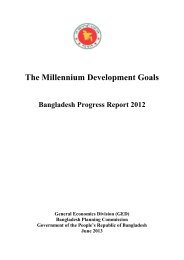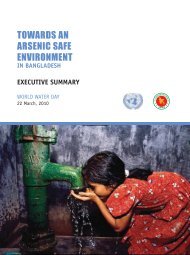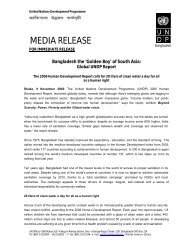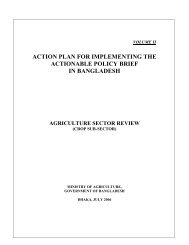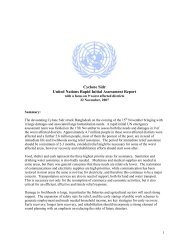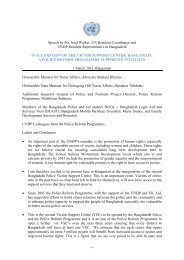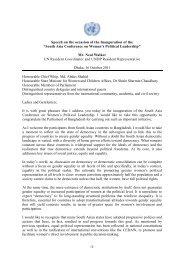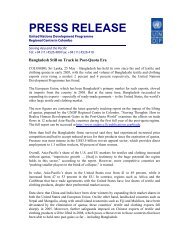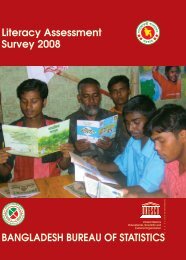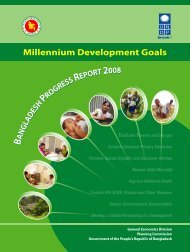STATE OF WOMEN IN CITIES 2012-2013 - UN-Habitat
STATE OF WOMEN IN CITIES 2012-2013 - UN-Habitat
STATE OF WOMEN IN CITIES 2012-2013 - UN-Habitat
Create successful ePaper yourself
Turn your PDF publications into a flip-book with our unique Google optimized e-Paper software.
<strong>STATE</strong> <strong>OF</strong> <strong>WOMEN</strong> <strong>IN</strong> <strong>CITIES</strong> <strong>2012</strong>-<strong>2013</strong><br />
civic engagement and governance. 71 Not only are women<br />
frequently under-represented in formal political structures,<br />
including trade unions, cooperative and workers’ associations,<br />
which marginalise their economic roles, 72 but where they do<br />
participate at the grassroots, they are often engaged in struggles<br />
for basic services. 73<br />
The recent shift towards decentralised governance has the<br />
potential to bring development decisions closer to communities<br />
and to reach those most marginalised such as particular groups<br />
of women. However, work undertaken by a range of grassroots<br />
women’s organisations has shown that for decentralisation<br />
to be meaningful to these women, their capacities to access<br />
entitlements and participate effectively in local governance<br />
must be enhanced. Unless women become active partners with<br />
cities and local governments, they will continue to remain on<br />
the margins of governance processes and to be excluded from<br />
development decisions that impact their communities. 74<br />
In the case of Peru, decentralisation has led to increased<br />
women’s engagement, organised around a series of laws that<br />
include citizen protection and mandates for participation.<br />
Women have engaged more in public affair through Local<br />
Coordinating Councils (LCCs) and in vigilance and<br />
monitoring committees. Projects such as the Casa de la Mujer<br />
(Women’s Home) have been central in addressing women’s<br />
issues like domestic violence and the equitable allocation of<br />
resources to women. 75 An integral aspect of these types of<br />
projects has been the training and organisation of grassroots<br />
women as leaders in their communities through ‘local to local<br />
dialogues’ which not only enhances women’s decision-making<br />
power but also deepens democracy. 76<br />
Conceptualising gender empowerment and urban<br />
prosperity nexus<br />
Using the framework on gender and urban prosperity as<br />
the foundation, it is useful to incorporate issues of women’s<br />
empowerment and especially their economic empowerment<br />
within the nexus. This highlights not only the range of gender<br />
disparities that need to be taken into account in order to<br />
generate prosperity, but also that reducing gender inequalities<br />
and inequities must be addressed in order to bring about<br />
women’s empowerment in cities at individual and collective<br />
levels as well as through a range of formal and informal<br />
institutions (Figure 1.1.3)<br />
Relationships between women<br />
empowerment, prosperity and<br />
urbanisation<br />
Conceptual frameworks such as that outlined in Figure<br />
1.1.3 are simplifications of reality. However, they can assist in<br />
identifying the sectors and issues that need to be addressed if<br />
women are to take advantage of urban prosperity as a way of<br />
improving their life chances. Yet it is also essential to remember<br />
that the relationships between urbanisation and prosperity in<br />
different cities around the world will play out in a wide range of<br />
Two young women in Cairo’s Tahrir Square play their part in the 2011 Egyptian Revolution<br />
© <strong>UN</strong>-<strong>Habitat</strong>/Taylor Barr<br />
14


